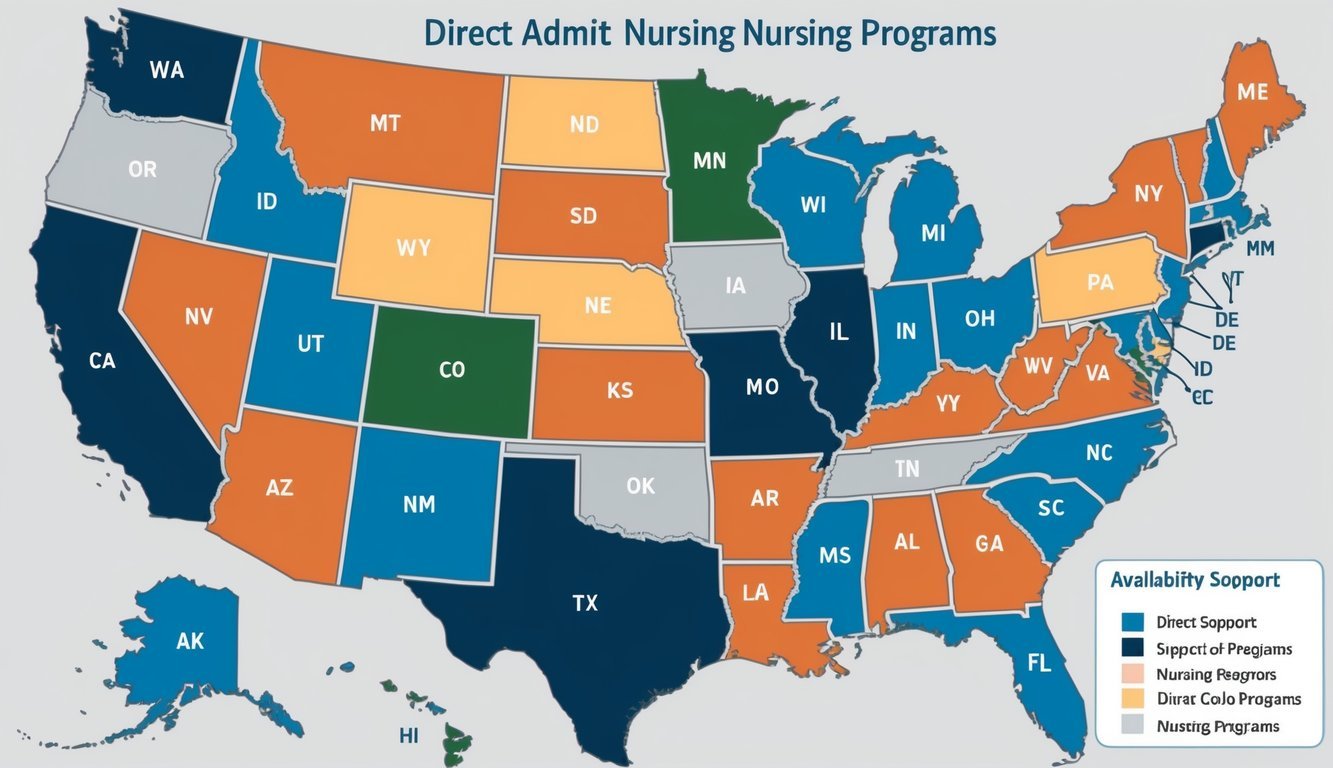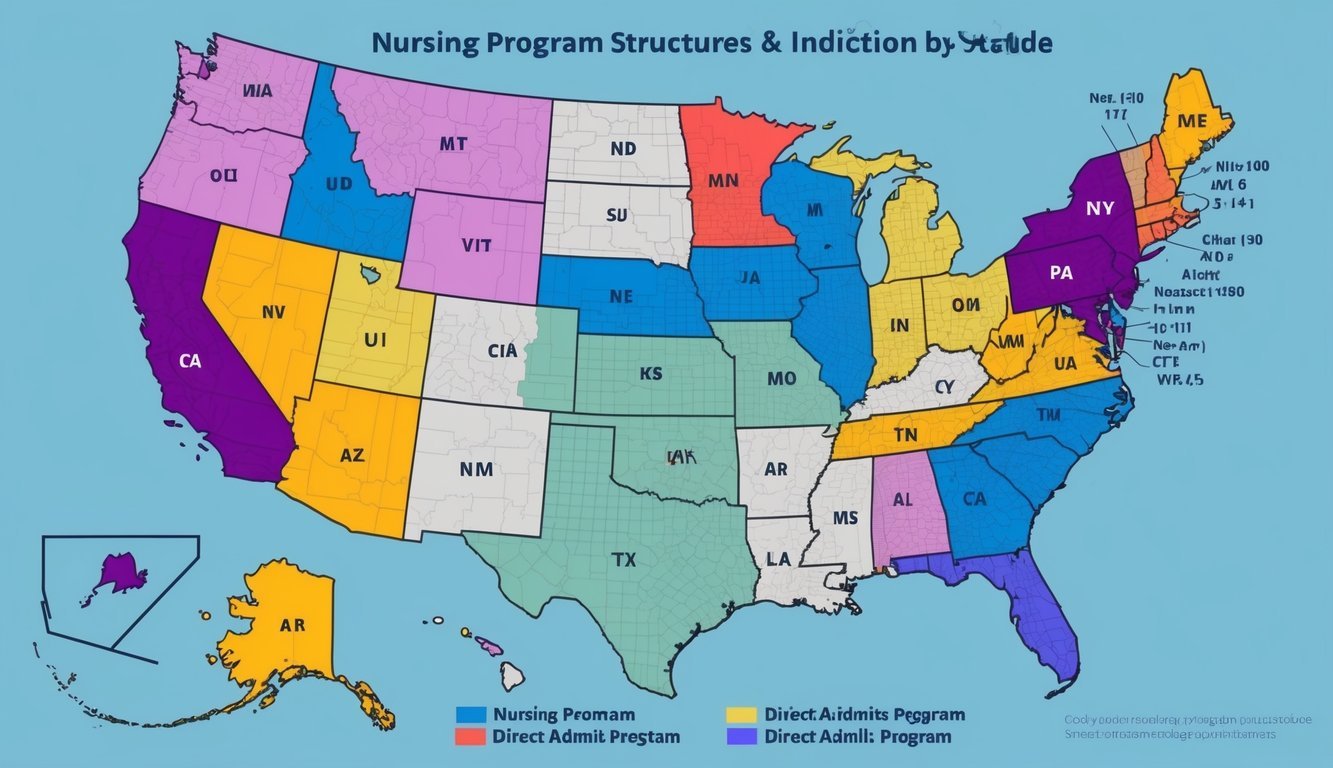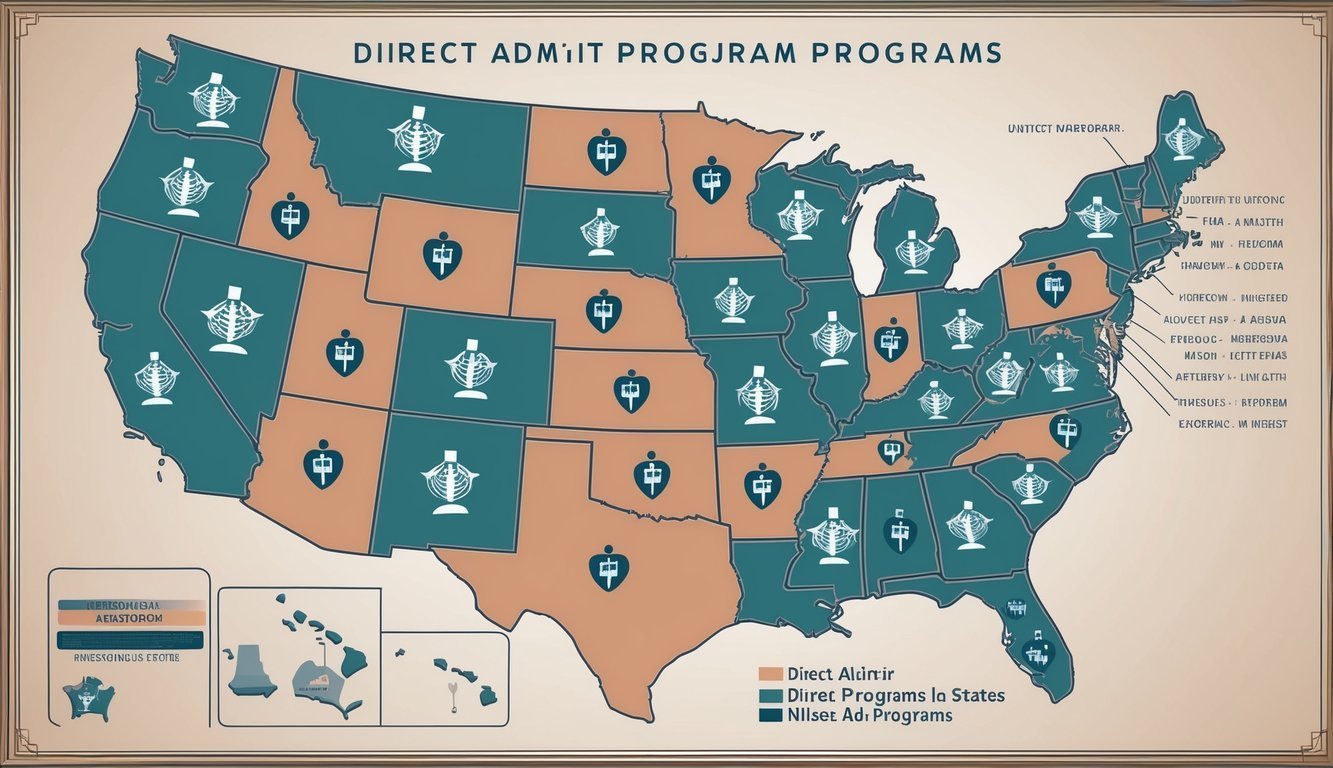Direct admit nursing programs are a great option for high school students who want to pursue a career in healthcare.
These programs allow you to gain guaranteed admission to a nursing school if you meet specific criteria.
This can save you time and reduce stress, as you won’t need to navigate through a separate application process after starting college.
In this post, you’ll explore direct admit nursing programs available in different states.
You’ll learn about admission requirements, program structures, and financial considerations to help you decide which program is right for you.
Understanding these factors is crucial as you prepare for a rewarding nursing career.
Key Takeaways
- Direct admit programs offer a straightforward path to a Bachelor of Science in Nursing.
- Admission criteria vary by state and can impact your eligibility.
- Financial support options are available to make nursing education more accessible.
Understanding Direct Admission in Nursing
Direct admission in nursing provides a streamlined path for students aiming for a Bachelor of Science in Nursing (BSN).
This approach allows students to secure their place in a nursing program from the start, without the stress of competing for entry later.
This section will explain what direct admission is and its significance, as well as outline the advantages it offers to future nursing students.
Definition and Significance of Direct Admission
Direct admission refers to a nursing program’s process that allows students to be accepted directly into the program based on their high school performance or standardized test scores.
This contrasts with traditional admissions, where students may apply after completing general education courses.
The significance of direct admission lies in its ability to offer students a clear and secure path to becoming registered nurses (RNs).
You can focus on your nursing education from day one, making it easier to plan your future career.
Many colleges and universities offer direct admit nursing programs, which cater specifically to competitive students looking for guaranteed entry into healthcare programs.
Advantages of Direct Admit Systems
Direct admit nursing programs provide several benefits.
First, students experience less anxiety about gaining acceptance after starting college.
You won’t have to compete with peers later on for limited slots in a nursing program.
Second, these programs often have a structured curriculum that integrates lower-division coursework and nursing core classes from the beginning.
This integration leads to a more cohesive learning experience.
Here are some advantages in a list format:
- Guaranteed Admission: You secure a spot in the nursing program upon admission.
- Reduced Competition: Focus on nursing without the pressure of reapplying.
- Structured Curriculum: Early nursing coursework fosters comprehensive training.
- Enhanced Support: Many programs provide dedicated academic advising.
These aspects make direct admit nursing programs an appealing choice for aspiring RNs who are ready to commit to their education in nursing from the onset.
Admission Requirements for Direct Admit Programs

When considering direct admit nursing programs, it’s essential to understand the admission requirements.
Each program may have different criteria, but some common elements include academic prerequisites, minimum GPA, standardized test scores, and supplemental materials like personal statements.
Academic Prerequisites and Minimum GPA
Most direct admit nursing programs require specific courses to be completed before applying.
These typically include:
- Biology: Often a foundational course.
- Chemistry: May include organic chemistry.
- Mathematics: College algebra is commonly required.
You will likely need to maintain a minimum GPA, usually around 3.0 on a 4.0 scale.
Some programs may be more competitive and ask for a higher GPA.
It’s crucial to check each program’s website for their exact requirements.
For instance, programs at institutions like the University of Miami often have specific course guidelines and GPA cutoffs.
Test Scores and Supplemental Materials
Many direct admit nursing programs require standardized test scores, such as the SAT or ACT.
The minimum score requirements can vary, but a score around 1100 on the SAT or 24 on the ACT is common for competitive programs.
In addition to test scores, you may need to submit a personal statement.
This is your opportunity to explain your interest in nursing and why you’re a good fit for the program.
Be sure to highlight relevant experiences and your motivation for pursuing a nursing career.
Some programs may also ask for letters of recommendation, so prepare those in advance to strengthen your application.
Always refer to Nursing CE Central for detailed guidance on specific programs’ requirements.
Financial Considerations and Support

Understanding the costs associated with direct admit nursing programs is essential for your planning.
You need to consider tuition, available financial aid, and scholarships that can help reduce your expenses.
Understanding Tuition Costs
Tuition costs for direct admit nursing programs vary by state and institution.
On average, you may expect to pay anywhere from $10,000 to $80,000 for the entire program.
Public universities often have lower tuition rates compared to private schools.
Here’s a simplified breakdown:
| Type of Institution | Average Tuition Cost |
|---|---|
| Public Universities | $10,000 – $30,000 |
| Private Universities | $30,000 – $80,000 |
In addition to tuition, you should also budget for books, materials, and clinical fees.
These additional costs can add up quickly, so thorough planning is key.
Scholarships and Financial Aid Options
Many opportunities exist for financial aid and scholarships.
Start by filling out the FAFSA (Free Application for Federal Student Aid) to determine your eligibility for federal grants and loans.
Consider these scholarship options:
- Institutional Scholarships: Many colleges offer scholarships specifically for nursing students.
- State Programs: Some states have grants aimed at supporting healthcare education.
- Private Organizations: Numerous organizations provide scholarships for nursing students, such as the American Nurses Association.
Be proactive in researching and applying for these financial aids as they can significantly lessen your financial burden.
Websites like Nurse.org and Fastweb have lists of current scholarships and financial assistance programs tailored for nursing students.
Nursing Program Structures by State

Understanding the nursing program structures in various states helps you make informed decisions.
Each program offers distinct features that cater to the needs of students.
California State University, Fullerton
California State University, Fullerton (CSUF) features a direct-entry Bachelor of Science in Nursing (BSN) program.
This program is competitive, admitting only 40 students each year.
To be considered, applicants must meet several requirements.
These include submitting an essay, two letters of recommendation, and completing an interview with faculty.
The BSN curriculum at CSUF covers essential nursing topics, such as health assessment, pharmacology, and community nursing.
Graduates are prepared for the California Registered Nurse (RN) licensing exam, which is essential for practicing nursing in the state.
For more details, visit CSUF Nursing Program.
University of Arizona
The University of Arizona offers a direct-entry BSN program through its College of Nursing.
This program is designed for freshmen who are directly accepted into the nursing major.
Students benefit from a comprehensive curriculum that includes theoretical knowledge and hands-on experience in clinical settings.
Key courses cover areas such as nursing fundamentals, pathophysiology, and leadership in nursing.
The program emphasizes critical thinking and clinical skills, preparing you for various nursing roles.
Graduates are eligible to sit for the NCLEX-RN exam.
More information can be found at University of Arizona Nursing.
University of New Mexico
At the University of New Mexico, the College of Nursing offers a direct-entry BSN option that focuses on a community-oriented approach.
This program integrates evidence-based practice throughout its curriculum.
You’ll engage with courses in health promotion, cultural competency, and nursing ethics.
The program also involves significant hands-on clinical experiences in various healthcare settings.
All graduates must take the NCLEX-RN exam to become registered nurses.
The University of New Mexico emphasizes developing compassionate care skills and preparing you for a dynamic healthcare environment.
Find out more at University of New Mexico Nursing.
Clinical Components in Nursing Education

Clinical components are a crucial part of nursing education.
They ensure that you gain practical experience that complements your coursework.
This training prepares you to face real-world healthcare challenges and develop the skills needed for effective patient care.
Hands-On Training and Clinical Hours
Hands-on training involves practical experiences in various healthcare settings.
These experiences are often referred to as clinical hours.
Most nursing programs require you to complete between 500 and 1,000 clinical hours.
This time allows you to apply your nursing coursework in real situations.
During clinical rotations, you will work with patients under the supervision of licensed nurses and instructors.
This mentorship helps you learn about patient assessment, treatment plans, and communication skills essential for healthcare.
The Role of Simulation in Nursing Curriculum
Simulation plays a significant role in nursing education.
It bridges the gap between classroom learning and clinical practice.
Utilizing high-fidelity mannequins and virtual scenarios, you can practice crucial skills without risking patient safety.
Simulated experiences allow you to build confidence and competence in areas like emergency care, pharmacology, and patient management.
Engaging in these scenarios prepares you for real-world situations.
Many programs incorporate a variety of simulations within the nursing curriculum to enhance your practical knowledge and decision-making skills.
Frequently Asked Questions
In this section, you will find answers to common questions about direct admit nursing programs.
The topics cover differences with traditional programs, state-specific application processes, and the advantages of choosing direct admit options.
What are the key differences between direct admit and traditional nursing programs?
Direct admit nursing programs allow students to secure a spot in a nursing program right after high school.
In contrast, traditional programs typically require students to complete prerequisite courses before applying.
This difference can save time and reduce the uncertainty of gaining admission later.
How does the application process for direct admit nursing programs vary by state?
Application processes can differ significantly based on state requirements.
Some states may require standardized test scores, while others focus more on GPA and extracurricular activities.
It is important to check specific state guidelines for detailed steps.
Which states offer the best direct entry BSN programs?
States such as Florida, Texas, and New York have been recognized for their top direct entry BSN programs.
Institutions in these states often feature high NCLEX pass rates and strong support systems for students.
You can explore the Direct Admit Nursing Programs offered in these areas for more details.
What are the advantages of enrolling in a direct admit nursing program?
Enrolling in a direct admit nursing program can provide several benefits.
You secure a place in nursing school without the stress of a separate application later.
These programs also often offer dedicated resources such as advising and mentorship from faculty.
Are there specific states known for easier admission into nursing programs?
Certain states might have less competitive admission processes for nursing programs.
States like Arizona and Tennessee often seek to fill their nursing positions, making entry into programs more accessible.
Always check admission statistics and requirements for each program you consider.
In which states do California State University campuses offer direct admit nursing programs?
California State University (CSU) campuses, such as CSU Los Angeles and CSU Chico, offer direct admit nursing programs.
These programs aim to prepare students promptly for the nursing workforce and meet California’s healthcare needs.
You can find more information on the programs available by visiting the CSU Nursing Programs.

